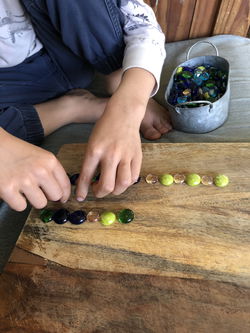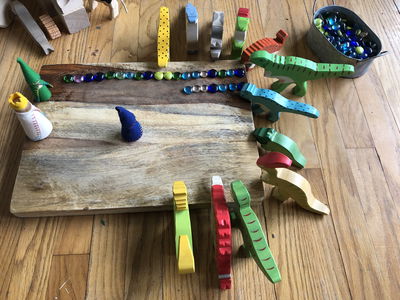I planned to do Addition in Sep and Oct, and Subtraction in Nov and Dec.
These are the files from TpT that I used:
We will do Multiplication in Jan/Feb/Mar and Division in Apr/May/Jun.
My students were okay with the idea of Addition and Subtraction, but they're worried about Multiplication and quite panicked over the idea of Division!
So this month we will start out by just focusing on what IS multiplication? Once students realize that multiplication is just a fast and easy way to do speed addition, I think their fears will melt away.
Montessori & Waldorf both believe in introducing all 4 operations right away when students begin to learn math. Waldorf does it with the Math Gnomes!

Making a Set of Waldorf Math Gnomes: Why & How
Addition
Addition is easy for children, as the plus symbol is basically the word "and".

10 is the same as 1 and 9
Subtraction
Subtraction can be easy when you call it "take away" but I don't introduce it to children that way! This over-simplification causes many problems later on. Then it is MUCH harder to recognize in word problems such as, "How much farther is Paris than Murphysboro?" "Ben had five goldfish and a tiger ate 3" is clearly subtraction. But... so is "How much younger is Zac than Grammy?"
So I talk to children a lot about how subtraction is about finding the difference between two numbers. In fact, the answer to a subtraction problem is literally called the "difference"! You can see this when you make both numbers out of gems, and one line is longer and it sticks out farther. The different part is the bit that sticks out. After a while, people realized they didn't need to make two lines of gems and see how much stuck out. They realized that they could just make the bigger number and remove the smaller number. Whatever is left over... is the difference!



a first grade problem
all the dinosaurs have come to help!
Multiplication
Multiplication is the same amount many times. It's speed addition! The thing that confuses children if you wait too long to introduce Multiplication is that the second number tells you how many times you have the first number. If you do Addition and Subtraction for too long (as the Common Core does), they just expect the second number to be either put together with, or taken away from, the first number. The idea that the second number could have a radically different job is EXTREMELY challenging then for children.
I think it really helps to FIRST ask your child to create a word problem that would be an example of multiplication. Where is it found in everyday life? We know that it is whenever anything comes in sets, like cartons of eggs or packs of gum, but does your child know that? Keep asking them to create multiplication word problems (no need to solve them) until this is simple.

I have also found that children don't automatically understand the relationship between multiplication and skip counting. I think that the book Multiplicando by Howard Schrager (author of LMNOP and All the Letters A to Z for the Capital Letters block and King Maximo and the Number Knights for the Quality of Numbers block) helps to make this connection more explicit.

Multiplicando
by Howard Schrager
I plan to actually read Multiplicando as part of our Mad Minutes time, since he introduces each line of the multiplication table with its own short chapter. For each set of number facts we will also sing that skip counting song.
I really like Aurora Lipper's FREE lesson where you have a child highlight all the times tables that they do know, and realize how few they actually need to memorize! Once you know the patterns in the 9s and have learned a few skip counting songs (3s and 4s), it's usually just the square numbers plus two or three more.
It is pretty inspiring! I'd like to do it at the beginning of January and again at the end of March. To do this activity at home, you would need a printed out 10x10 multiplication table, a highlighter, a piece of paper, and a pencil.
-
Multiplication Chart for 1-10 and 1-12 - FREE
print page 4 (in b&w)
Then watch Aurora's video!
I actually know a trick for 7 x 8, so that leaves only TWO that you have to straight-up memorize.
For 7 x 8, think of a dance teacher counting out the beat before the dance begins...
5, 6, 7, 8.
56 is 7 x 8!
I have a few more resources from TpT that I'd like to use as we work on memorizing multiplication facts. "Which multiple does not belong?" is such a fabulous idea for building number sense, and I'm really excited about it!
- Multiplication Fact Fluency Activities BUNDLE - $19.60
This bundle is expensive, so if you want to see a FREE sample, she made them!
x10 - FREE
x2 - FREE
Genius!
I plan to kick things off with a simple x0 Mad Minute first.
-
Mad Minutes x0 Multiplication Fluency - FREE
print page 4
In January & February, we will use Multiplicando and the Skip Counting Songs and Which Multiple Does Not Belong? exercises, and go through the same part of the times table all together. I want to make sure everyone is exposed to all of it.
week of Jan 6 - x0, x1
week of Jan 13 - x10, x5
week of Jan 20 - x2, x3
week of Jan 27 - x4
week of Feb 3 - x6
week of Feb 10 - x7
week of Feb 17 - x8
week of Feb 24 - x9
When it comes time for the students to practice their multiplication tables, I really like this super-flexible Mad Minute option that allows children to just put in the multiple they are working on. I love that they get to set their own goals... and that I don't have to keep track of a million pieces of paper. I also like that she puts the blank in two different places in the problem!
In March, the children can then work on the table that they are personally stuck on. And I can just print out the same PDF for each child each day!
- Multiplication Quick Practice - FREE
print page 3
Once children know their multiplication tables, they will realize that the division fact practice will be very easy! It's really the same thing.
Understanding multiples is also extremely useful for understanding percents, which Waldorf does in 6th grade as part of the Business Math block.
This post contains affiliate links to materials I truly use for homeschooling. Qualifying purchases provide me with revenue. Thank you for your support!






 Immersive Experience
Immersive Experience Immersive Experience
Immersive Experience







No comments:
Post a Comment